

The 2016 global opportunity report. Drivers of change. Drivers of Change investigates the key global issues and trends driving change in our societies and markets.
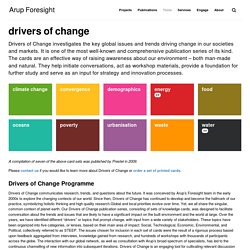
It is one of the most well-known and comprehensive publication series of its kind. The cards are an effective way of raising awareness about our environment – both man-made and natural. They help initiate conversations, act as workshop materials, provide a foundation for further study and serve as an input for strategy and innovation processes. A compilation of seven of the above card sets was published by Prestel in 2009. Please contact us if you would like to learn more about Drivers of Change or order a set of printed cards.
42837897. Untitled. Biodiversity, water and natural resource management. Biodiversity is fundamental to sustaining life, providing critical ecosystem services, such as food security, water purification, nutrient cycling, and climate regulation, that are essential to support human well-being and economic growth.
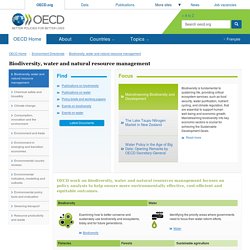
Mainstreaming biodiversity into key economic sectors is crucial for achieving the Sustainable Development Goals. Read more Lake Taupo is New Zealand’s largest lake, and a national icon. Its pristine waters attract visitors from round the world for a multitude of water-based recreation and sight-seeing activities. It is also important to New Zealand’s indigenous peoples. Read more "Putting the information revolution to work for water" opening Remarks by Angel Gurría, OECD Secretary-General at the "Let's talk about water" panel and film event on Water Policy in the Age of Big Data, 21 September 2015, Paris, France.
An oecd horizon scan of megatrends and technology trends in the context of future research policy. Megatrends Watch Institute. Global mega trends. Revolution 2: Resource Management. Future state 2030 v3. Global Annual Review 2014: Climate change and resource scarcity by Dennis Nally. As the world becomes more populous, urbanised and prosperous, demand for energy, food and water will rise.
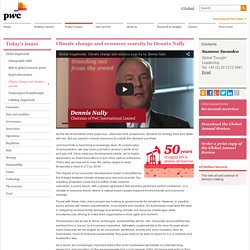
But our planet’s natural resources to satisfy this demand are finite. Just how finite is becoming increasingly clear. At current rates of consumption, we may have just half a century’s worth of oil and gas left. Yet to meet our development needs, we’re highly dependent on fossil fuels which in turn drive carbon emissions. That’s why we look set to miss the carbon target to keep temperature rises to 2°C by 2034. The impact of our economic development model is amplified by the linkage between climate change and resource scarcity. Faced with these risks, many people are looking to governments for solutions. The European environment — state and outlook 2015 — European Environment Agency. A comprehensive assessment of the European environment's state, trends and prospects, in a global context.

The synthesis report informs future European environmental policy in general and its implementation between 2015 and 2020 in particular. It includes a reflection on the European environment in a global context, as well as chapters summarising the state of, trends in, and prospects for the environment in Europe. European briefings present the state, recent trends and prospects in 25 key environmental themes, grouped in three clusters: environment; socio-economic; and systemic perspectives. Country briefings provide an overview of state of the environment across 39 European countries, based on national state of environment reports.
Regional briefings cover three regions, identified as priority areas in the EU's 7th Environmental Action Programme. Countries briefings *under the UN SCR 1244/99 Continued economic growth? Marine environment: Seas and oceans act as a coherent ecosystem. Megatrends 2016. Horizon Scanning - What trends and disrupters are visible to groups outside government? All large organisations, not just governments, need to take the long-term view.

Many have some kind of dedicated function to help them do so, whether they call it horizon scanning, futures, foresight or anything else. As part of our work in the Horizon Scanning Programme Team it's useful for us to keep up to date with what these other organisations are looking at; it helps us to validate our own work and to find external partners to work with. At the start of the year we undertook an informal scan of the trends and issues that are on other organisations’ radars 1.
For example, by reviewing forward-looking work such as the World Economic Forum’s Global Risks report, Shell’s global energy scenarios, the European Commission’s Horizon2020 programme. The result is summarised below. Future of Energy and Environment. Annual key factors report 2012. Agriculture and Food Production Contribute Up to 29 Percent of Global Greenhouse Gas Emissions According to Comprehensive Research Papers. COPENHAGEN (31 October, 2012)—Feeding the world releases up to 17,000 megatonnes of carbon dioxide into the atmosphere annually, according to a new analysis released today by the CGIAR Research Program on Climate Change, Agriculture and Food Security (CCAFS).
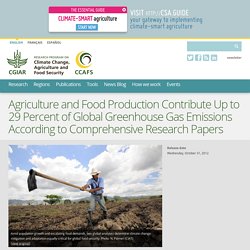
But while the emissions “footprint” of food production needs to be reduced, a companion policy brief by CCAFS lays out how climate change will require a complete recalibration of where specific crops are grown and livestock are raised. Sustainable food production: Facts and figures. Farming must feed more people more sustainably.
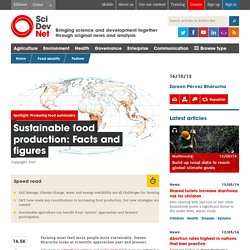
Zareen Bharucha looks at scientific approaches past and present. Advances in agricultural science and technology (S&T) have contributed to remarkable increases in food production since the mid-twentieth century. Global agriculture has grown 2.5–3 times over the last 50 years. [1] This has let food production keep pace with human population growth so that, overall, there are enough calories produced per capita. However, progress toward reducing hunger is variable across the world (see figure 1).